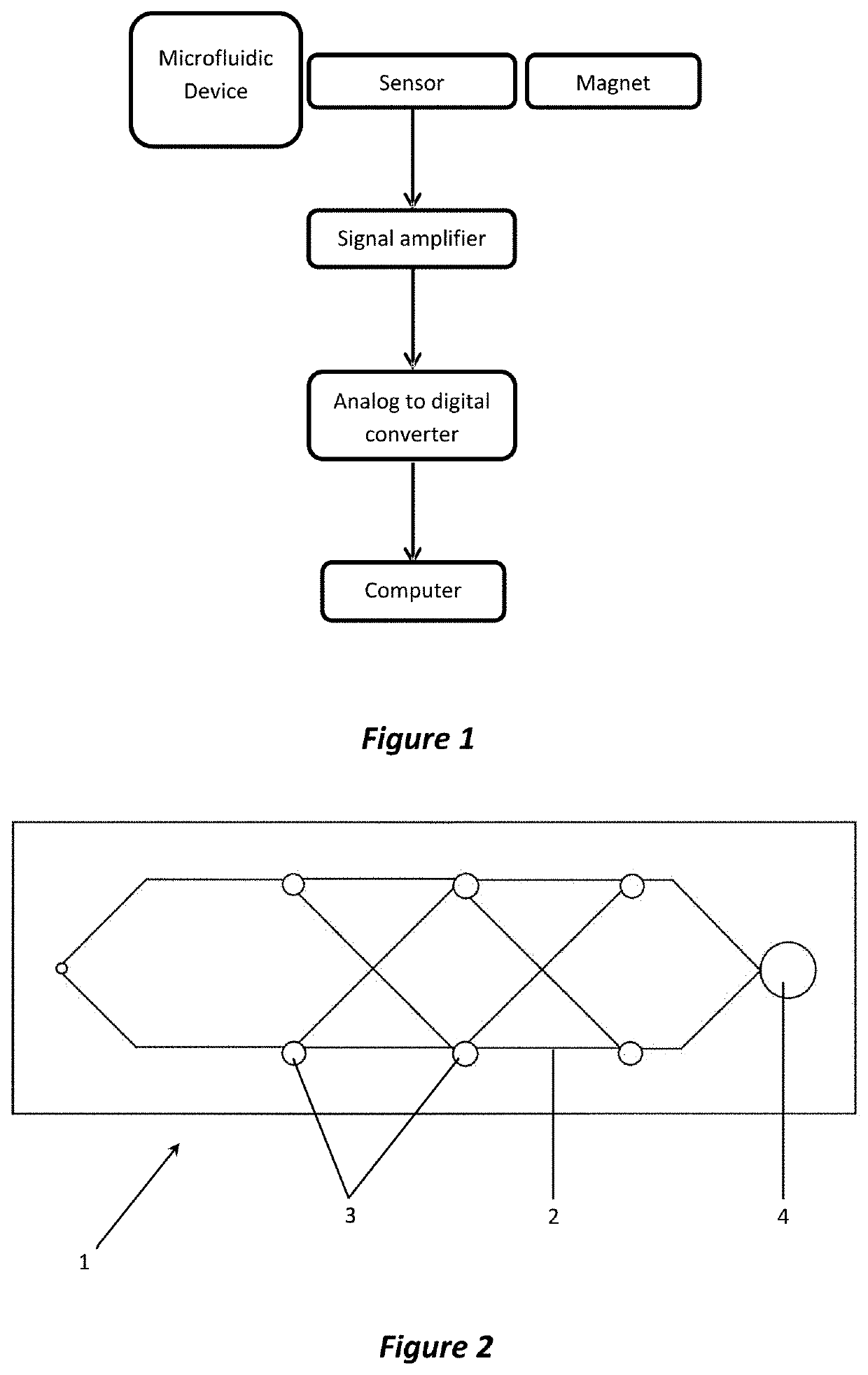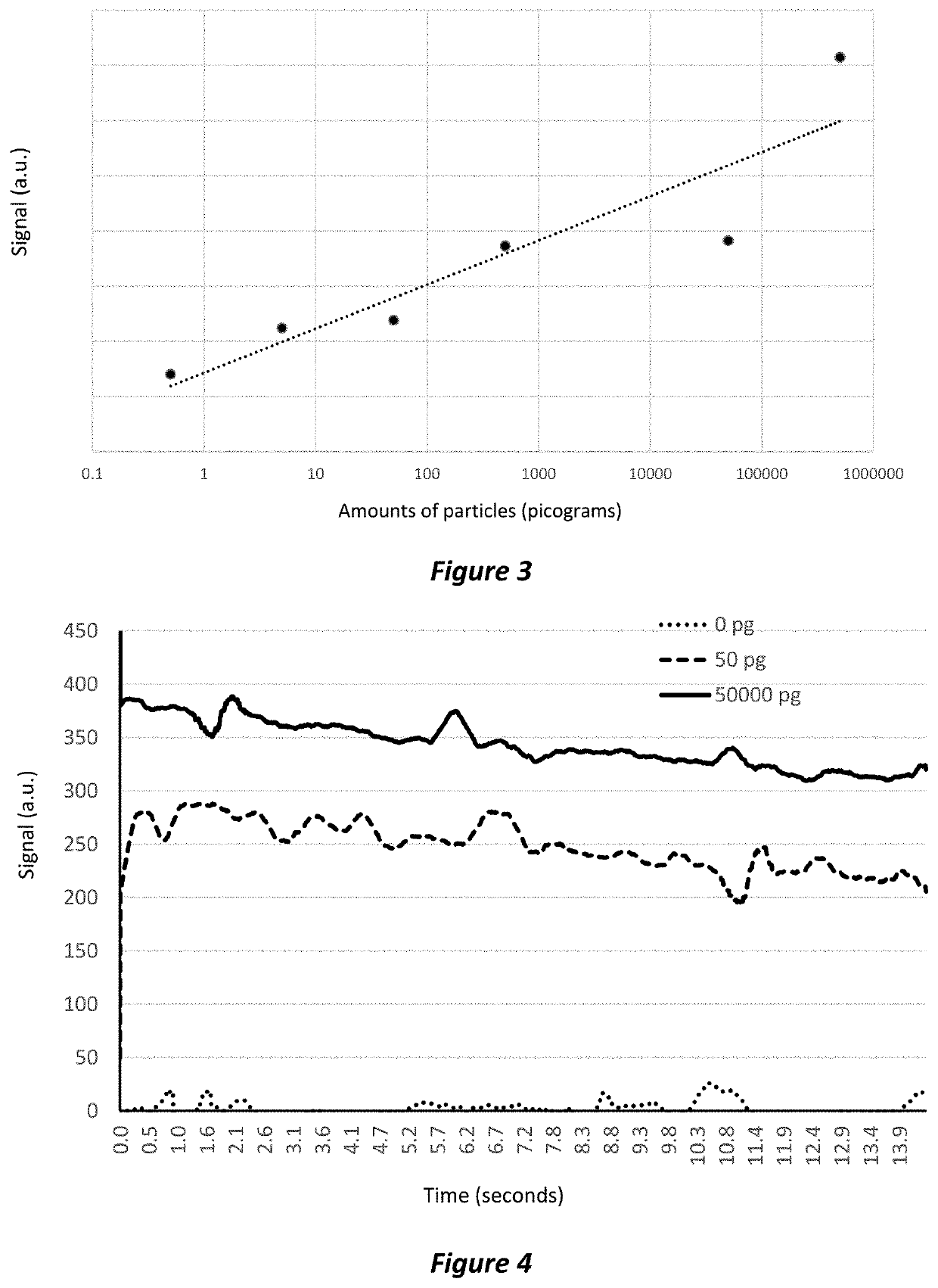Use of magnetic nanoparticles for the detection and quantitation of analyte(s)
- Summary
- Abstract
- Description
- Claims
- Application Information
AI Technical Summary
Benefits of technology
Problems solved by technology
Method used
Image
Examples
example 1
ty and Limit of Detection
[0306]The purpose of this study was to test the sensitivity of detection.
[0307]Specific amounts of magnetisable particles were added to the microfluidics system for detection. The setup of the system is summarised below.[0308]Magnetic sensor: Honeywell HMC 1021S magnetometer[0309]Magnetisable particles: Thermo Fisher Dynaparticles T1 (1 μm) Streptavidin particles[0310]Biolabel: Streptavidin[0311]Amplifier: Texas Instrument INA826[0312]Number of particles:[0313]Sample 1: control—0 pg of particles[0314]Sample 2: 0.5 pg of particles[0315]Sample 3: 5 pg of particles[0316]Sample 4: 50 pg of particles[0317]Sample 5: 500 pg of particles[0318]Sample 6: 50,000 pg of particles[0319]Sample 7: 500,000 pg of particles[0320]Acquisition of sensor data:[0321]0.012 seconds per read[0322]1,200 reads per sample[0323]approximately 15 seconds total read time
[0324]After being introduced into the microfluidics system the particles were positioned over the sensor by the microfluidi...
example 2
Detection
[0331]The purpose of this study was to test the speed of detection system.
[0332]Specific amounts of magnetisable particles were added to the microfluidics system for detection. The setup of the system is summarised below.[0333]Magnetic sensor: Honeywell HMC 1021S magnetometer[0334]Magnetisable particles: Thermo Fisher Dynaparticles T1 (1 μm) Streptavidin particles[0335]Biolabel: Streptavidin[0336]Amplifier: Texas Instrument INA826[0337]Number of particles:[0338]Sample 1: control—0 pg of particles[0339]Sample 2: 50 pg of particles[0340]Sample 3: 500,000 pg of particles[0341]Acquisition of sensor data:[0342]0.012 seconds per read[0343]1,200 reads per sample[0344]approximately 15 seconds total read time
[0345]After being introduced into the microfluidics system the particles were positioned over the sensor by the microfluidics device. The magnet was activated to bring the magnetisable particles into close proximity to the magnetic sensor. The magnet was then turned off and a pe...
example 3
of Streptavidin Protein in a Sample
[0353]The purpose of this study was to demonstrate quantitative detection of streptavidin protein in a sample as a target analyte.
[0354]Biotin conjugated to latex-particles (non-magnetisable particles) were used to capture and associate with specific amounts of streptavidin added to the microfluidics system for detection. The setup of the system is summarised below.[0355]Magnetic sensor: Honeywell HMC 1021S magnetometer[0356]Magnetisable particles: Thermo Fisher Dynaparticles T1 (1 um) Streptavidin particles[0357]Biolabel: Streptavidin[0358]Amplifier: Texas Instrument INA826[0359]Samples[0360]Sample 1: 0 pmoles / ml streptavidin protein conjugated to the magnetisable particles[0361]Sample 2: 0.33 pmoles / ml streptavidin protein conjugated to the magnetisable particles[0362]Sample 3: 3.3 pmoles / ml streptavidin protein conjugated to the magnetisable particles[0363]Sample 4: 33 pmoles / ml streptavidin protein conjugated to the magnetisable particles[0364]...
PUM
 Login to View More
Login to View More Abstract
Description
Claims
Application Information
 Login to View More
Login to View More - R&D
- Intellectual Property
- Life Sciences
- Materials
- Tech Scout
- Unparalleled Data Quality
- Higher Quality Content
- 60% Fewer Hallucinations
Browse by: Latest US Patents, China's latest patents, Technical Efficacy Thesaurus, Application Domain, Technology Topic, Popular Technical Reports.
© 2025 PatSnap. All rights reserved.Legal|Privacy policy|Modern Slavery Act Transparency Statement|Sitemap|About US| Contact US: help@patsnap.com


